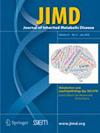Evaluation of early treatment with intravenous idursulfase and intrathecal idursulfase‐IT on cognitive function in siblings with neuronopathic mucopolysaccharidosis II
IF 4.2
2区 医学
Q1 ENDOCRINOLOGY & METABOLISM
引用次数: 0
Abstract
Mucopolysaccharidosis II (MPS II; Hunter syndrome; OMIM 309900) is a rare, X‐linked, heterogeneous lysosomal storage disease. Approximately two‐thirds of patients develop cognitive impairment, which is difficult to assess in clinical trials, partly owing to the variable nature of cognitive impairment. Analyzing data from siblings can help to minimize this heterogeneity. We report analyses of cognitive function from siblings with MPS II enrolled in clinical trials: a natural history study (NCT01822184), a randomized, open‐label, phase 2/3 study of intravenous (IV) idursulfase with or without intrathecal idursulfase (idursulfase‐IT; NCT02055118), and its extension (NCT2412787). Cognitive function was assessed using Differential Abilities Scales, Second Edition General Conceptual Ability (DAS‐II GCA) scores; Bayley Scales of Infant and Toddler Development, Third Edition; and Vineland Adaptive Behavior Scales, Second Edition Adaptive Behavior Composite (VABS‐II ABC). Seven sets of siblings (six pairs and one set of three) were included. All patients received IV idursulfase and 10 received subsequent idursulfase‐IT. Younger siblings initiated IV idursulfase at an earlier age than their older sibling(s) in six of the sets; the younger sibling started treatment before 1 year of age in three sets. Monthly idursulfase‐IT was generally associated with a stabilization of cognitive function: DAS‐II GCA and VABS‐II ABC scores were higher at age‐matched assessments in the majority of those who either received idursulfase‐IT earlier than their sibling or who received idursulfase‐IT versus no idursulfase‐IT. These data suggest that early initiation of intrathecal enzyme replacement therapy may stabilize or slow cognitive decline in some patients with neuronopathic MPS II.静脉注射伊都磺酸酶和鞘内注射伊都磺酸酶-IT的早期治疗对神经病理黏多醣症II同胞认知功能的影响评估
黏多醣症 II(MPS II;亨特综合征;OMIM 309900)是一种罕见的 X 连锁异质性溶酶体储积病。约有三分之二的患者会出现认知障碍,这在临床试验中很难评估,部分原因是认知障碍的性质多变。分析兄弟姐妹的数据有助于最大限度地减少这种异质性。我们报告了对参加临床试验的 MPS II 患者同胞认知功能的分析结果:一项自然史研究(NCT01822184),一项关于静脉注射(IV)伊度硫酸酯酶联合或不联合鞘内伊度硫酸酯酶(idursulfase-IT;NCT02055118)的随机、开放标签、2/3 期研究,以及其扩展研究(NCT2412787)。认知功能使用差异能力量表第二版一般概念能力(DAS-II GCA)评分、贝利婴幼儿发育量表第三版和文兰适应行为量表第二版适应行为综合评分(VABS-II ABC)进行评估。其中包括七组兄弟姐妹(六对和一组三人)。所有患者均接受了伊度硫酸酯酶静脉注射,其中10人随后接受了伊度硫酸酯酶-IT治疗。在其中六组患者中,年幼的兄弟姐妹比年长的兄弟姐妹更早开始接受静脉注射伊度硫酸酯酶治疗;在三组患者中,年幼的兄弟姐妹在一岁前就开始接受治疗。每月一次的伊度硫酸酯酶-IT通常与认知功能的稳定有关:在与年龄相匹配的评估中,大多数患者的 DAS-II GCA 和 VABS-II ABC 得分都要比其兄弟姐妹更早接触伊度硫酸酯酶-IT,或者接受伊度硫酸酯酶-IT 与未接受伊度硫酸酯酶-IT 的患者的得分更高。这些数据表明,尽早开始鞘内酶替代疗法可能会稳定或减缓某些神经病理性 MPS II 患者的认知功能衰退。
本文章由计算机程序翻译,如有差异,请以英文原文为准。
求助全文
约1分钟内获得全文
求助全文
来源期刊

Journal of Inherited Metabolic Disease
医学-内分泌学与代谢
CiteScore
9.50
自引率
7.10%
发文量
117
审稿时长
4-8 weeks
期刊介绍:
The Journal of Inherited Metabolic Disease (JIMD) is the official journal of the Society for the Study of Inborn Errors of Metabolism (SSIEM). By enhancing communication between workers in the field throughout the world, the JIMD aims to improve the management and understanding of inherited metabolic disorders. It publishes results of original research and new or important observations pertaining to any aspect of inherited metabolic disease in humans and higher animals. This includes clinical (medical, dental and veterinary), biochemical, genetic (including cytogenetic, molecular and population genetic), experimental (including cell biological), methodological, theoretical, epidemiological, ethical and counselling aspects. The JIMD also reviews important new developments or controversial issues relating to metabolic disorders and publishes reviews and short reports arising from the Society''s annual symposia. A distinction is made between peer-reviewed scientific material that is selected because of its significance for other professionals in the field and non-peer- reviewed material that aims to be important, controversial, interesting or entertaining (“Extras”).
 求助内容:
求助内容: 应助结果提醒方式:
应助结果提醒方式:


